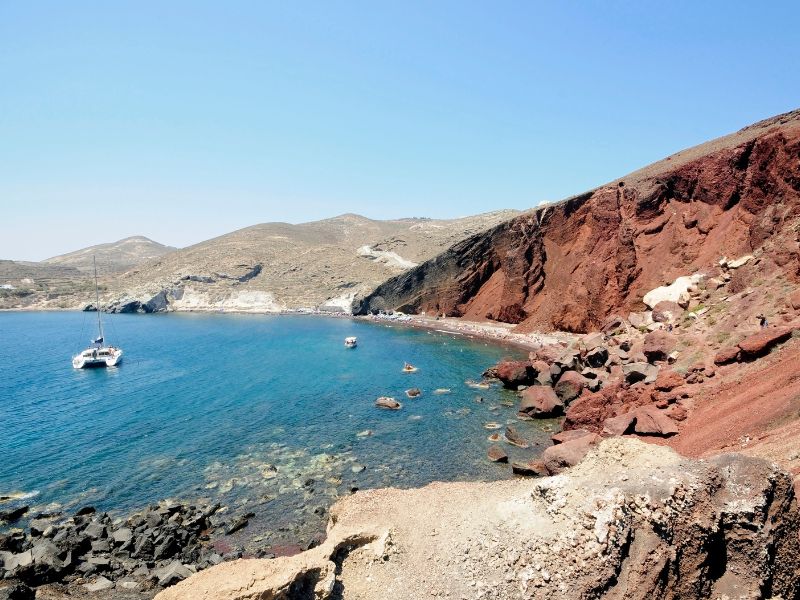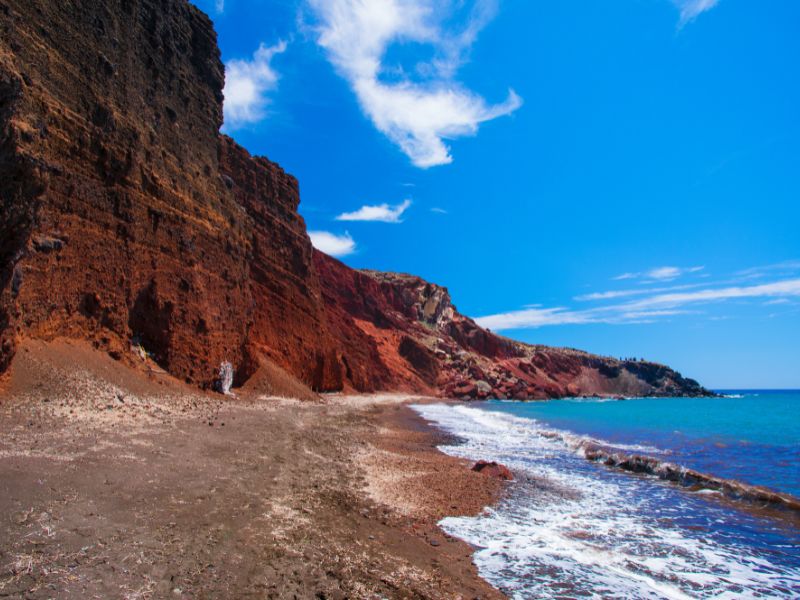Table of Contents
Introduction
The first glimpse of Red Beach in Santorini feels almost theatrical: a sheer wall of rust-red volcanic rock plunges into electric-blue sea, with dark sand shimmering between them like iron filings under bright light.
From the headland path the contrast is startling, and the scent of warm basalt drifts upward each time a wave retreats. Few shorelines anywhere combine such bold color with the calm of a hidden cove, making this small sweep of coast one of the island’s most arresting natural spectacles.
Birth of a Scarlet Coast – Volcanic Origins

Red Beach owes its dramatic palette to the same forces that carved Santorini’s crescent caldera. During the Late Bronze Age eruption, iron-rich lava exploded from vents south of Akrotiri, cooled in mid-air, and settled in layers that turned deep crimson as iron oxidised.
Centuries of wind and salt spray later sculpted the cliffs into fluted buttresses, and gravity sent fragments tumbling down to create a sand-and-pebble shore tinted brick red. Because erosion exposes fresh rock every winter, the color remains vibrant rather than fading, so each season the beach looks newly painted by the island’s fiery past.
Arriving at Red Beach in Santorini
Most visitors reach the shoreline on foot from the small parking area near the Chapel of Agios Nikolaos, a short drive beyond Akrotiri village. A rough path descends in ten minutes—sturdy shoes beat flip-flops for grip on loose scree—and the final corner suddenly reveals the full vista of crimson cliffs framing turquoise water.
Those who prefer to skip the hike can ride a boat taxi from Akrotiri harbour or Perissa; the skippers drop anchor just beyond the wave break, letting passengers step directly onto the sand. Shade arrives only in late afternoon when the sun slips behind the ridge, so early arrivals should pack a wide hat, extra water, and reef-friendly sunscreen.
Facilities are minimal: a seasonal kiosk rents umbrellas and cold drinks, but restrooms and loungers are absent, preserving the raw character of the cove.
Swimming, Snorkeling and Staying Safe

The sea shelves quickly yet remains glass-clear, revealing a mosaic of lava boulders streaked in ochre and charcoal. Gentle surf invites confident swimmers to explore, though waves can rebound unpredictably against the concave cliff on gusty days.
A natural breakwater of rocks guards the southern edge, fostering pockets of calm where snorkelers glide above shoals of rainbow wrasse and curious damselfish. Visibility often exceeds twenty metres, especially in the morning before sand stirs.
Small warning signs at the path entrance remind visitors that rockfalls are possible; sitting directly under the highest overhangs is unwise. Instead, many beachgoers set towels closer to the water, where pebbles are cooler and the view stretches unbroken across the Saronic Gulf.
Nearby Sights and Easy Detours
Because Red Beach lies a stone’s throw from major landmarks, combining shoreline relaxation with cultural discovery is effortless. The prehistoric city of Akrotiri rests barely five minutes away by car, its roofed excavation sheltering three-storey homes frozen beneath pumice since the seventeenth century BCE.
Boat shuttles departing the main sandbar reach White Beach in under ten minutes, threading between rust-red headlands before revealing chalky cliffs and pale shingle kissed by emerald water.
Late afternoon often sees visitors climb the trail above Red Beach for a wide-angle panorama, then linger until the sun ignites the cliff face in ochre and ember tones—an ideal vantage for photographers chasing golden light without the crowds of Oia.
Capturing the Colour – Best Light and Photo Tips

Mid-morning sun emphasises the stark contrast between scarlet rock and sapphire sea, but subtle hues emerge when shadows lengthen after four o’clock. A polarising filter deepens blue reflections and tames glare on wet stone, while drone pilots (where permitted) gain a striking aerial of red rock encircled by indigo.
If using only a phone, descending the trail at shoreline level allows the cliffs to fill the frame; kneel near the waterline so waves blur into a silver edge beneath the rising monolith.
Conclusion
Iron-rich lava, relentless Aegean wind, and crystal water collaborate to craft a shoreline unlike any other in Greece. From the first step onto dark sand to the last dip beneath ochre cliffs, Red Beach in Santorini delivers a vivid lesson in volcanic artistry—one that lingers long after the red dust has been rinsed from shoes and snorkel masks.
Pack a sense of wonder alongside sturdy footwear, and let the island’s most colourful cove reward the effort with unforgettable colour and calm.

